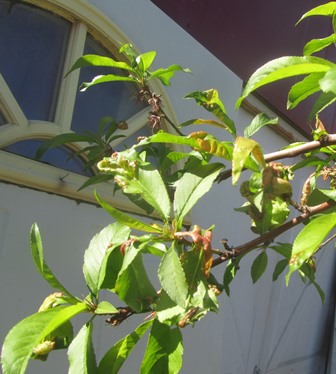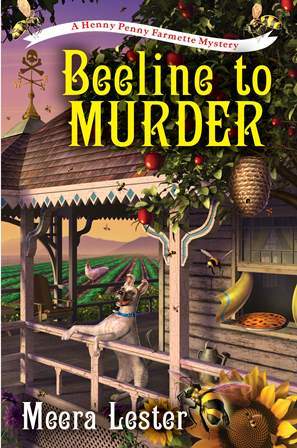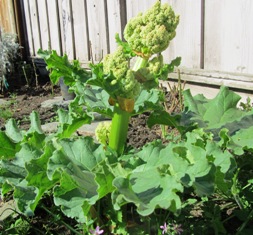The Challenge of Dealing with Peach Leaf Curl
The rains have turned Northern California hills and fields green with wild grasses and weeds. On my farmette, the fruit trees are blooming and the peaches have leafed out. The dreaded peach leaf curl is apparent on many leaves of my peach and nectarine trees.
The peach leaf curl disease is caused by a fungus, Taphrina deformans, according the integrated pest management information posted on the U.C. Davis site: http://www.ipm.ucdavis.edu/PMG/PESTNOTES/pn7426.html. This fungal infection can involve virtually every part of the tree, especially the new leaves, young twigs, new shoots, and fruits. It winters over, too, ready to infect the new growth in the spring.
Picking off the affected leaves and disposing of them in a garbage bag (never in the compost pile) seems intuitive as new the tree will produce new leaves. However, until it does, the tree is exposed to sunburn.
Many expert gardeners say the most effective treatment is prune in the fall to remove any affected branches and twigs. Spray the tree with a fixed copper fungicide after the leaves have fallen in November.
If the winter rains are heavy, you may need another round of spraying in the spring before the blossoms open. Failure to control this fungus can result in the decline of the of quality fruit and ultimately the death of the tree.
Copper fungicide, like any pesticide, is a poison. If you decide to use it, follow the directions on the packaging. Do not spray on a windy day or where the possibility of the spray can drift and contaminate areas where vegetables are ready to be picked.
Organic approaches are less effective but include the following:
1. Keep the plant healthy, but don’t over-fertilize it because that produces more tissue for potential infection.
2. Use good hygiene on and around the tree. Remove diseased leaves, twigs, and fallen leaves and discard (not in the compost pile).
3. Consider replacing the susceptible tree with a peach tree that is more resistant to peach leaf curl such as Redhaven or cultivars of Redhaven.
4. If you defoliate the tree, allow it to re-foliate in warm, dry weather when re-infection is less of a problem. Also thin the fruit crop in a season when there is a particularly severe infection because that will help keep the plant vigorous.
For more tips for farming, gardening, keeping bees and chickens, check out my Henny Penny Farmette series of cozy mysteries. Each chapter features almanac sayings and ends with farming tips or delicious recipes. The books are available through Amazon.com, Barnesandnoble.com, as well as other online and conventional bookstores everywhere.
Rhubarb–That “Pie Plant”
In my grandmother’s time, rhubarb’s moniker was the “pie plant” for the simple reason that the tart flavor of its canes nicely tempers the cloying sweetness of other fruits.
Rhubarb, long treated as a fruit, is actually a vegetable. In bygone days when tariffs on imported vegetables were higher than on fruit, a New York court decided in favor of labeling rhubarb as fruit for the purposes of taxation and tariff regulations.
One of the first edibles in the spring garden, rhubarb pushes up leaf stalks or canes (what botanists call petioles) with large leaves. The leaves are are high in oxalic acid and thus poisonous to consume (when harvesting, cut off the tops and discard; snap off the canes for cooking).
Rhubarb stalks or canes, when cooked with sugar or apples (to sweeten), are delicious in pies, jams, sauces and fruit tarts.
Rhubarb is easy to grow (in warm climates, it grows year-round). In cold climates, its leaves and canes will die but the rhizome root will generate new shoots come spring. But if it blooms, cut off the bloom to ensure the root continues to produce canes.
The plant can also be grown in large containers or in greenhouses. It is not fussy about soil, produces new canes year after year, and loves sunlight.
Consumers love those red canes, but rhubarb canes, depending on the variety, aren’t always red–some are light green or pink speckled. The flavor of the light green canes, the type growing on our farmette, has the most robust flavor.
While creating a space for some new plants, we decided to dig out one of our rhubarb plants. That little rhizome I put in the ground four years ago had produced roots 20 inches into the earth. Above ground the plant had grown roughly three feet high and as wide. We will divide it and replant, since it’s a good idea anyway to divide every 3 to 4 years.
We grow Victoria, an old variety with a tendency to flower (or bolt). We prefer to remove those flower spikes in order to keep the plant producing new canes and leaves. Blooms tend to waste the plants resources, see http://www.gardeningknowhow.com/edible/vegetables/rhubarb/rhubarb-bolting.htm. Also see, http://www.hort.purdue.edu/ext/rhubarbflowers.html
In an upcoming posting, I’ll include some recipes for using rhubarb from your garden. In the meantime, consider the different varieties available and perhaps try planting a new and different cultivar. See, http://www.rhubarbinfo.com/varieties.
 Facebook
Facebook Goodreads
Goodreads LinkedIn
LinkedIn Meera Lester
Meera Lester Twitter
Twitter









